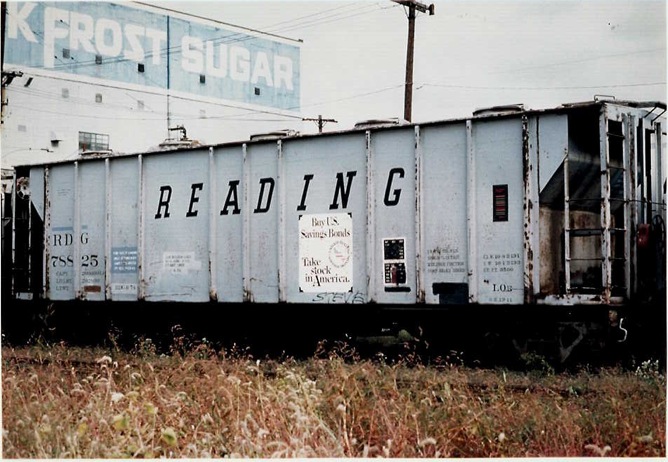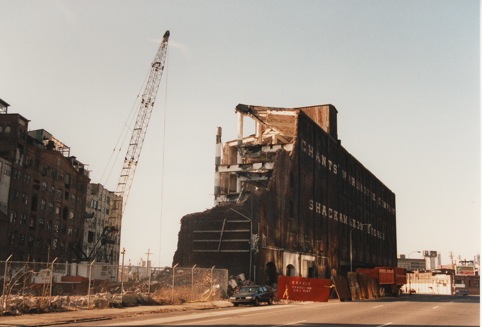
Reading Railroad covered hopper car #78825 was specifically assigned to Jack Frost to carry refined sugar to customers. The blue patch near the left end of the car just to the right of the "25" reads "For sugar loading only. When empty return to RDG Co Pt Rch, Pier 43".
Jack Frost Sugar Refinery, c.1901-1940
1001-1071 Penn Street, Philadelphia PA 19125
© Stuart Paul Dixon,
Workshop of the
World (Oliver Evans Press, 1990).
In 1881, Fishtown's first
sugar refinery, owned by the Pennsylvania Sugar Refining
Company, began operating in the area bounded by the
Delaware River to the south, Laurel Street to the west,
Penn Street to the north, and Shackamaxon Street to the
east. The complex also includes one building on the east
side of Shackamaxon Street connected to the rest of the
complex by an above-ground conveyor system. The National
Sugar Refining Company, better known as Jack Frost,
acquired Penn Sugar in 1947. Active sugar refining at the
complex halted in 1984 after National Sugar sold the
property.
Composed of approximately eighteen buildings on the
Fishtown waterfront, the Jack Frost complex today stands
as a silent reminder of Fishtown's past industrial
vitality. Among these eighteen buildings are a
by-products building, pan house, melter house, char
house, bagging facility, boiler house, pump house,
storage sheds, an office building, and a shipping and
receiving building. The complex was described in 1937 as
rising "in a strangely shaped geometrical brick mass,
from which protrude at fantastic angles a variety of
tanks and metal pipes." 1
This description
depicts the complex's appearance to this
day.
Beginning at the northwest corner of the complex, a
six-story reinforced-concrete building, eight bays in
width faces Penn Street. Built in 1924, this structure
functioned as the by-products building. East of it is a
six-story, three-bay building; according to an 1950
Sanborn insurance map, it contained a laboratory with
filler tanks. A seven-story, 10-bay pan house with a
raised brick cornice and a shallowly-sloped center gable,
stands to the east of the preceding two buildings. A date
stone set in the pediment of the gable gives 1901 as the
year of construction. Remodeled in 1927, this structure
contained pulverizers on the first and second floors and
dry ovens on the third floor; the dry ovens were used in
preparing the raw sugar for melting. East of the 1901 pan
house, a three-story boiler house stands with eleven
exhaust stacks protruding above its roof. The boiler
house was described by the 1950 Sanborn as containing
engines and dynamos on the first floor, and economizers
on the second. A three-story warehouse and office
building stands to the east of the boiler house; behind
it is a twelve-story char house. A one story
shipping and receiving building, erected in 1940 stands
to the east of the office building across Shackamaxon
Street.
Buildings to the rear of these structures consist of a
seven-story melter house, a six-story fire tower, a
nine-story refinery, and a seven-story char house; the
char house was constructed in 1901. Another three-story
boiler house lies to the rear along, with a nine-story,
five-bay by thirteen-bay-deep pump house with coal
bunkers. A five-story steel-frame warehouse built in 1915
sits on a pier in the Delaware River, along with a
three-story storage house, a three-story facility for the
bagging and storage of raw sugar, and a three-story wharf
house. A four-story rum and gin storage house rises on
another pier into the Delaware River.
When the Pennsylvania Sugar Refining Company began
operations at this site in early 1881, it occupied five
buildings rebuilt from an earlier soap and oil works.
From molasses and syrup, Penn Sugar manufactured soft and
brown sugar, employing approximately 40 men in the
process. Two boilers were used to refine the sugar, while
a 100 h.p. engine drove 24 centrifugal machines. The
original brick and frame buildings were demolished as
Penn Sugar expanded and rebuilt the facilities to their
near-present state in the early twentieth century. Penn
Sugar appears as six brick buildings in a 1895 atlas. A
1910 atlas shows three large brick buildings and a frame
wharf. In 1916, Penn Sugar employed over 300 men and
women, and had an office staff of 73 people.
In the 1930s, the refinery imported dark brown, raw sugar
in 325-pound bags from Caribbean and Pacific basin
islands. 2
Unloaded at the
refinery's docks on the Delaware, the sugar was dumped
into hoppers and conveyed to the melter house where the
sugar crystals were saturated with syrup in minglers.
Centrifugals, similar to clothes dryers, washed the now
fluid sugar free of impurities and molasses. The fluid
sugar was then converted into a thick syrup in the
melters, "a maze of piping and tanks." After filtering
through metal cloth covered with silica, the syrup was
pumped "to the char house, a 12-story building filled
with an array of pumps, piping, batteries of filters 10
feet in diameter by 25 feet deep, and oil-burning kilns
for revivifying the char."
The filtered liquid then proceeded to the pan house,
where "large tanks built of heavy copper plates and
fitted with steam coils, a condenser, and a vacuum pump"
lowered the temperature of the syrup, compelling the
liquid to form crystals. The size of the crystals varied
from fine "caster sugar" to one-quarter-inch rock candy.
"Centrifugals (bronze baskets 40 inches in diameter, with
finely perforated screen perimeters) spin toplike at a
speed of 1,000 revolutions per minute, ejecting the syrup
while the crystals remain on the screen to be washed. The
wet sugar is delivered to the revolving dryers for drying
and separation into various sizes." Automatic weighing
and packing machines filled the sugar into bags and
cartons that had capacities ranging from 2 to 100 pounds.
For some customers the sugar was packed in wooden barrels
that contained 350 pounds.
Cubes and tablets were made in cylindrical presses, while
powdered sugar was made in pulverizers from standard
sugar. The last product of the refining process, called
black strap molasses, was sent to the by-products
building. "Here it is used for alcohol production, being
mixed with yeast which breaks up the glucose into alcohol
and carbonic acid gas." The gas had its alcohol content
boiled off in a continuous still and was then packed for
sale as an antifreeze, a flavoring, and a solvent.
1 Federal Writers
Project, Works Progress Administration,
Philadelphia,
A Guide to the Nation's
Birthplace,
(Harrisburg, 1937), p. 532.
2 The description of the
following sugar production process was taken from
the WPA
Guide to Philadelphia (1937), pp. 532-33.

Demolition (1997).
Update May
2007 (by
Torben Jenk):
On June 29, 1997, the
ten-story Jack Frost Sugary Refinery withstood multiple
attempts to destroy it with explosives. On Nov 2, 1997,
with 700 lbs of explosive set in 4,000 charges, the
remaining building was successfully imploded through
"controlled demolition." After a detailed structural
analysis, a minimum amount of explosives is strategically
placed in holes drilled in critical support columns or
strapped to support beams. These are detonated in an
exquisitely timed sequence lasting from milliseconds to a
full nine seconds. Weight and gravity do the
rest. The goal is to implode things down, usually
collapsing a structure inward within its footprint but
sometimes the building is laid down in a predetermined
direction to avoid damage to adjacent structures.
In December 2006, this site was one of two selected for a
casino along the Delaware River in Philadelphia. The
investors are promoting it as the "Sugar House Casino"
and propose a $550 million casino and entertainment
project with up to 5,000 slot machines operating 24 hours
a day. The legislation permitting casinos was introduced
by state politicians seeking new revenues for
Pennsylvania, supported by wealthy local investors.
Because the enabling legislation limited the voice of
neighboring residents and even the Philadelphia Zoning
Board, lawsuits and petitions have been filed and are
winding their way through the courts.
See
also:
History of the Pennsylvania Sugar
Company—Jack Frost, Ken Milano (presentation
May 24, 2006).